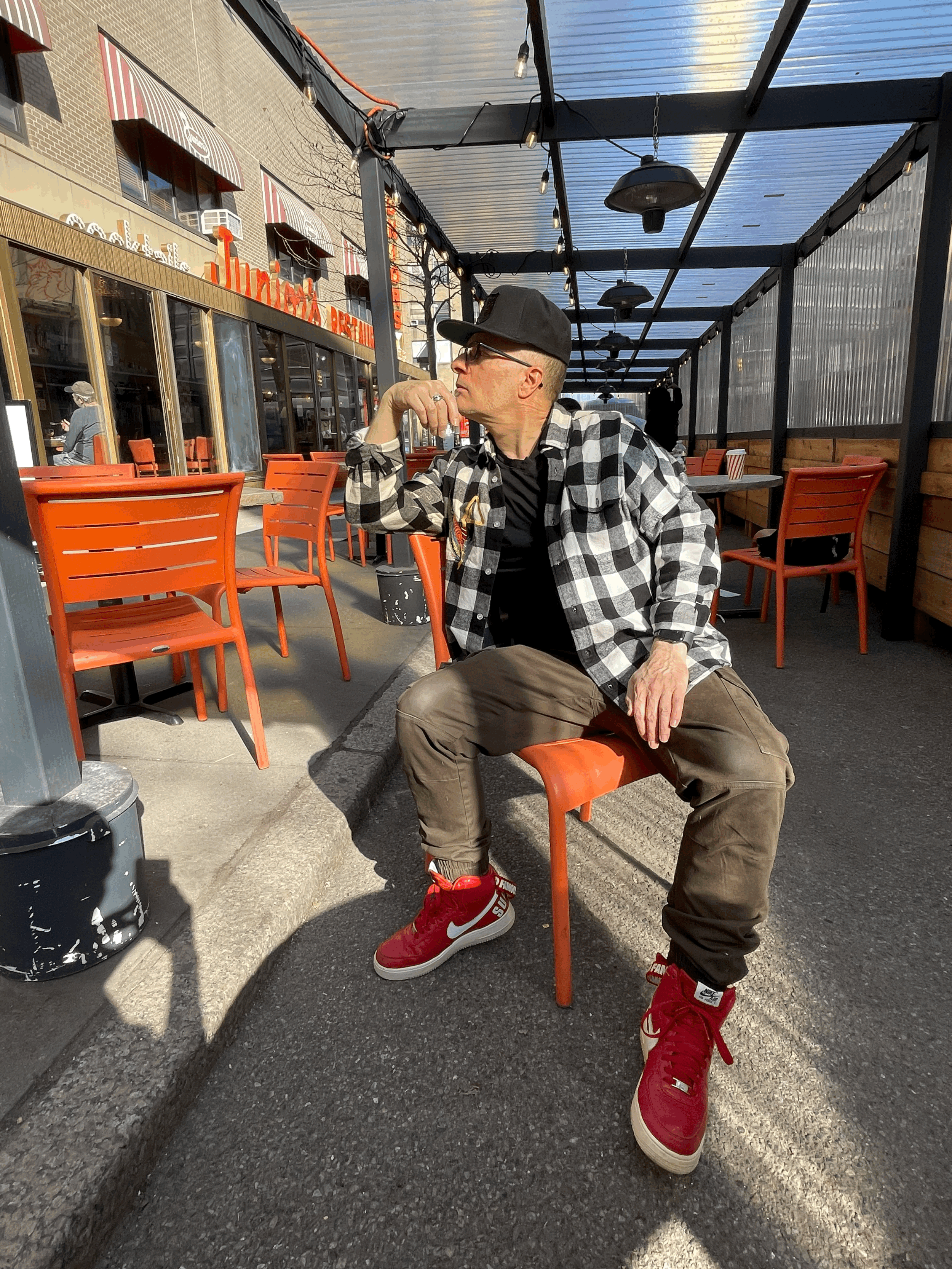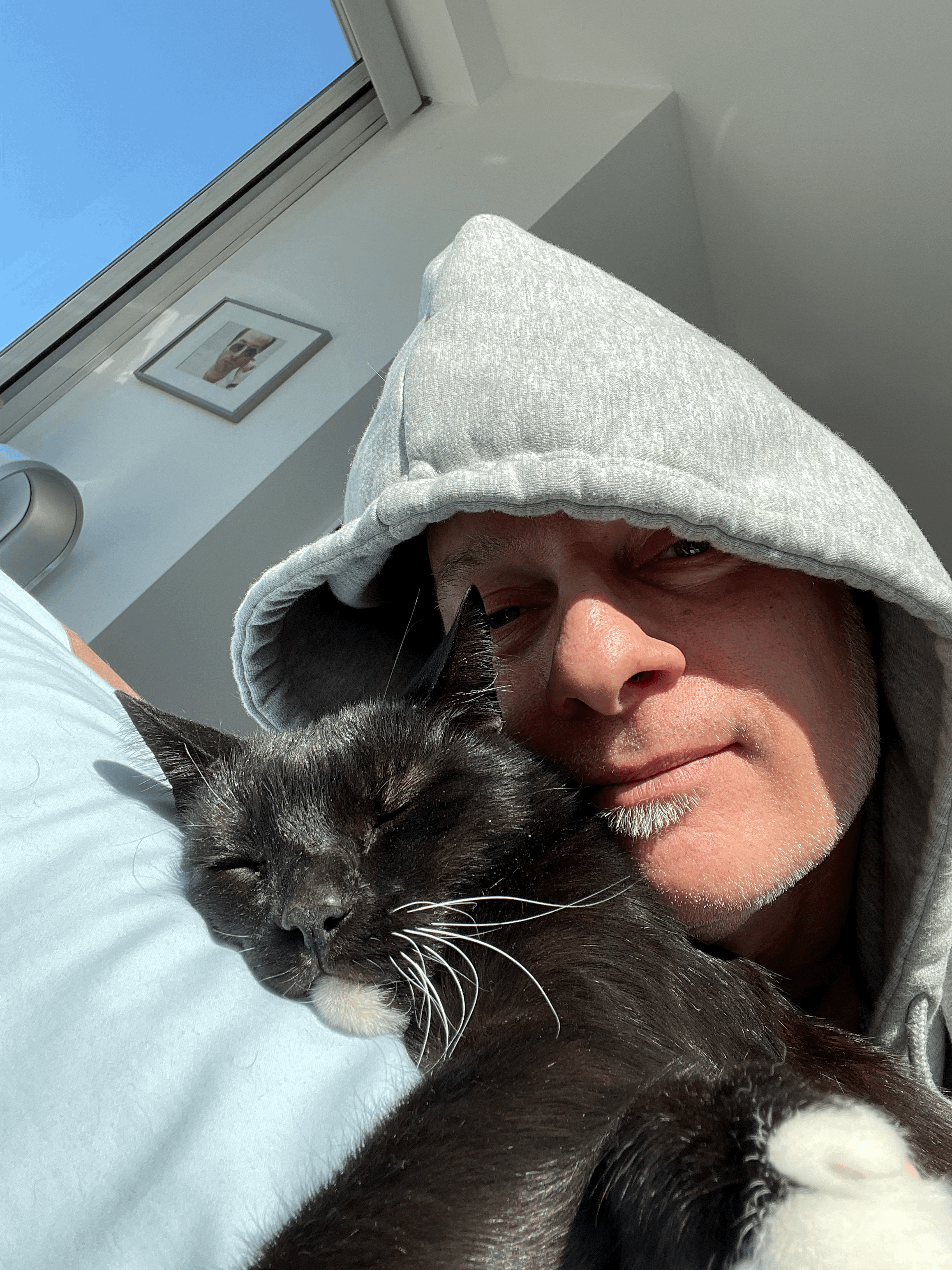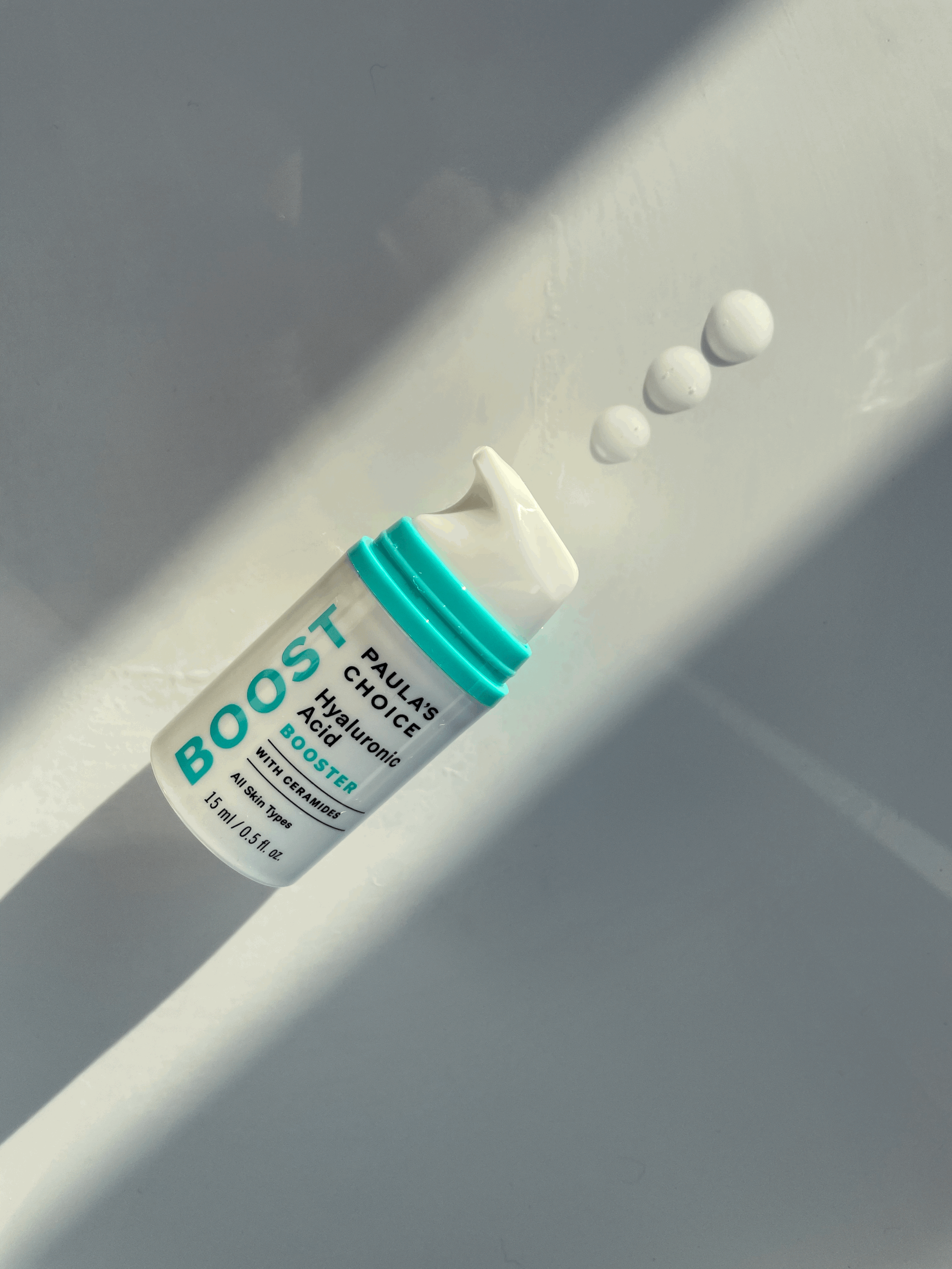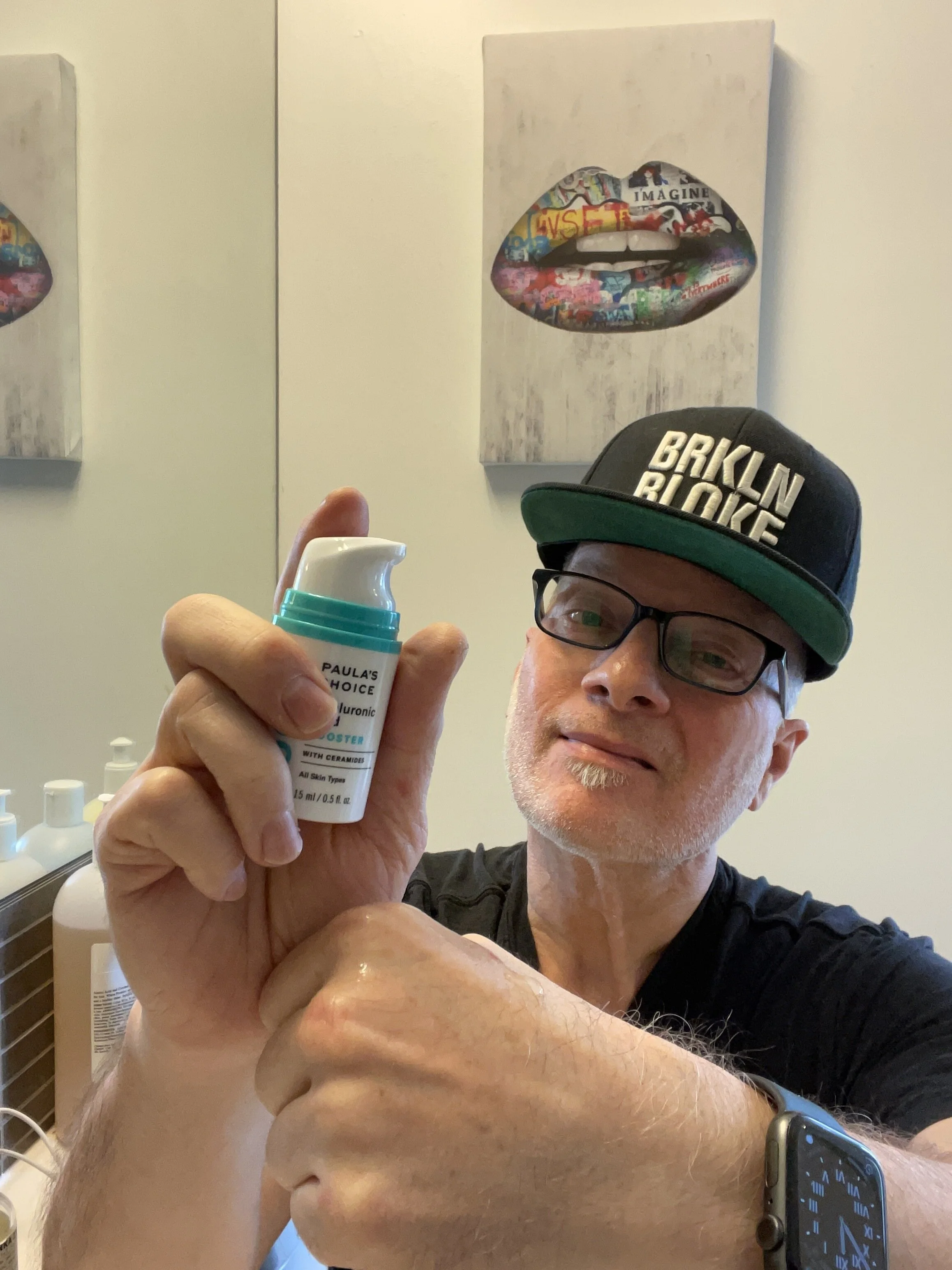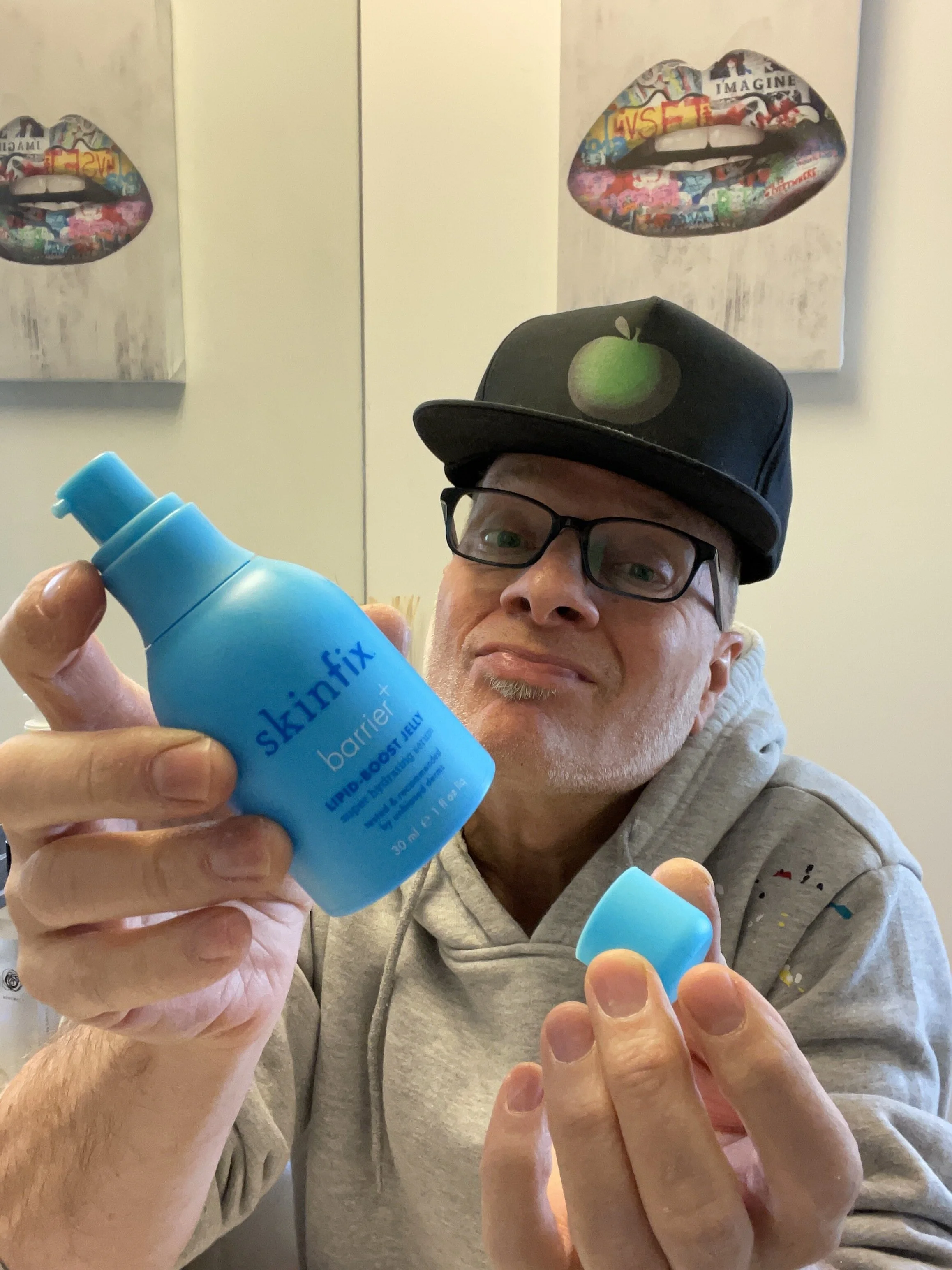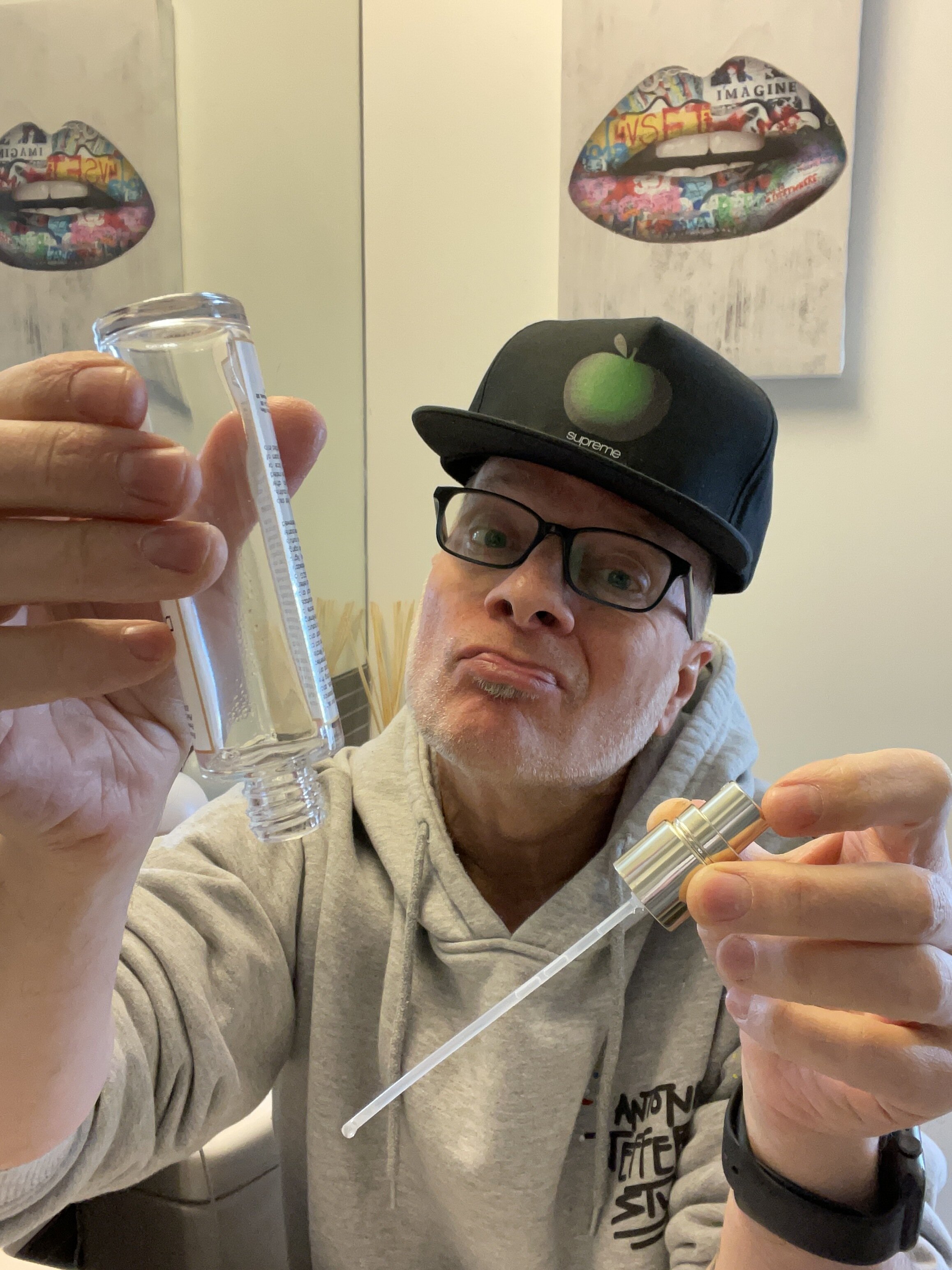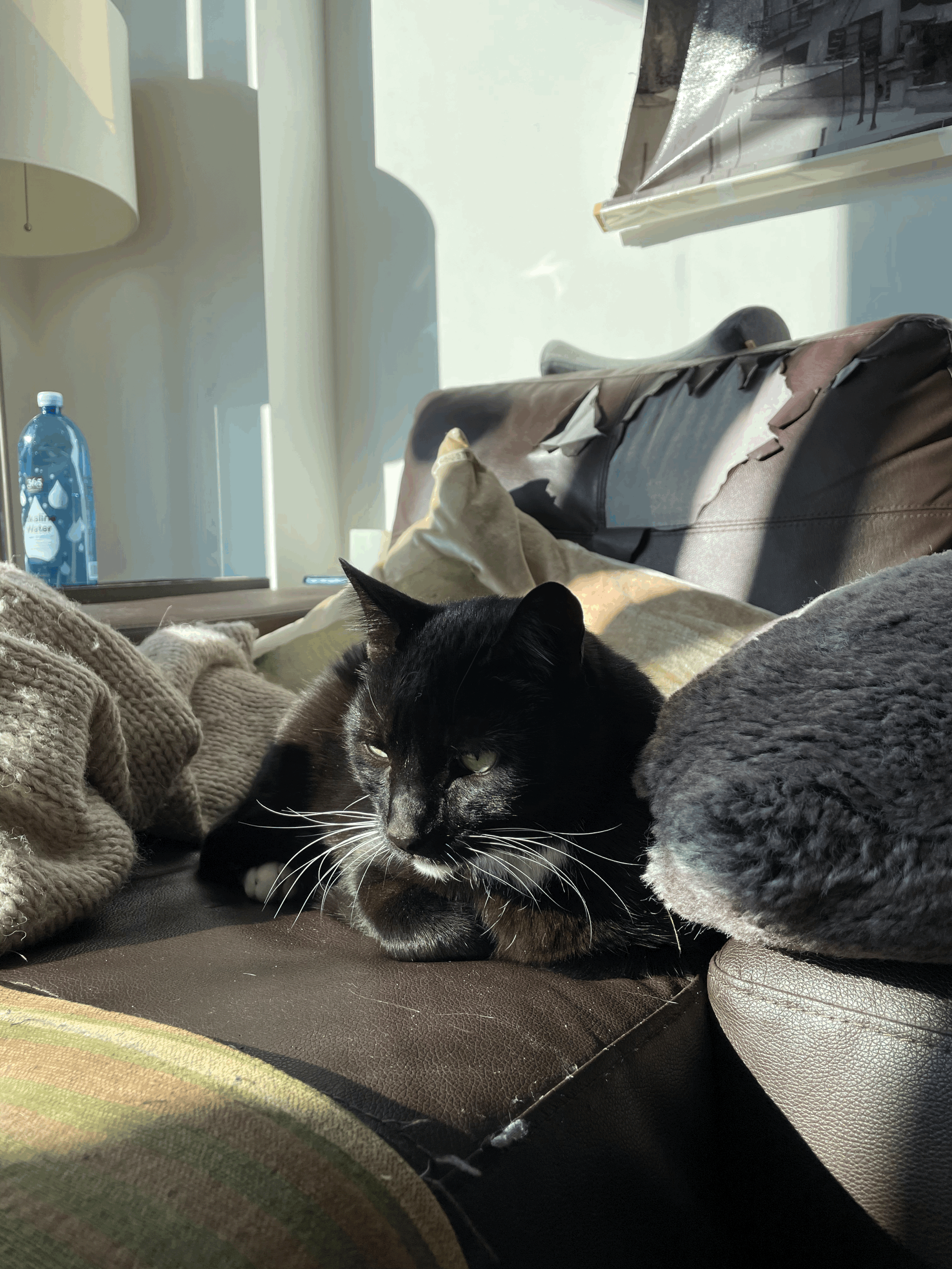MY WINTER EMPTIES 2020: SERUMS, CLEANSERS AND TONERS FROM DRUNK ELEPHANT, SKINFIX, PAULA'S CHOICE AND MORE!
I spent the past week exploring the boundaries of my half-freedom.
By that, I mean the in-betwixt time between my two Covid vaccines. It’s a surreal period that is both oddly liberating and understandably disconcerting at the same time.
I got my first Covid shot, the Pfizer vaccine, ten days ago. Over the course of the first weekend, I had a sore arm but have experienced no other discernible side-effects.
That’s despite being warned by everyone and their mother (including my own!), that I would feel run down, apathetic, have a headache.
Shot-in-the-arm number two is scheduled for next Friday, March 26th in Crown Heights, Brooklyn — just two subway stops away from me. It’s funny to me how close to home it all ends. I can’t wait. That’s going to feel as close to being fully freed from the sludge of the past year as I think is possible right now.
So the in-betwixt time makes me feel a little bit free, but not fully free. It’s hard to describe. It’s like having one foot stuck in cement, while the other is flailing about attempting to break free.
And so I ventured out into the old, new world last week. On an uncharacteristically warm day, a preview of spring, I had lunch in Manhattan.
Nothing could possibly feel more familiar, yet more foreign than going into the City for lunch. I’ve done it thousands of times over the past 18 years.
So, I ventured out and met a friend at a vegan Chinese restaurant in the West Village. He’s among the first to move back after escaping NYC at the beginning of the pandemic.
Aside from the risk of catching Covid, eating Chinese is a whole different risk for me. Chinese cuisine is heavily dependent on soy sauce, tofu, nuts, and even MSG; all of them major migraine triggers. But I was feeling invincible. It’s the in-betwixt time, after all!
And sure enough, I paid the price of that small gesture of freedom with a pretty intense migraine the following day.
I’m not sure if it was worth it, but every delicious bite sure tasted like freedom…
The skincare stuff starts here.
Spring has certainly sprung here in New York City. And, reflecting back on my skincare journey over the past three months, it’s apparent that I was heavily focused on hydration. More than any other winter season of the past, I took pains to prevent dehydration throughout the day. In both my AM and PM routines, I hydrated like a madman. A dry madman!
No matter what you do, in the low-humidity air of a cold winter’s day, it can be challenging to maintain proper hydration levels and keep skin from experiencing trans-epidermal water loss, or TEWL. As I’ve shared, TEWL is perhaps the least understood, yet most pro-aging skin condition.
We aren’t conditioned to understand the effects of dehydration on the skin. Especially as those effects relate to aging of the skin and the visible signs of aging — including fine lines, wrinkles, uneven skin tone and sensitivity. Lack of sufficient water in the skin’s upper layers compromises the most basic of skin functions, including defending against environmental damage and the desquamation process — or cell turnover.
What Is Trans-Epidermal Water Loss (TEWL)?
There’s an excellent article on the health website Skin Better titled, What Is Transepidermal Water Loss and Why Is it Important? available here. In the piece, the author defines TEWL as follows:
“The skin is comprised of three primary layers: the epidermis, the outermost layer; the dermis or middle layer; and the hypodermis, the undermost layer. When water passes from the dermis through the epidermis and evaporates from the skin’s surface, this is known as transepidermal water loss (International Journal of Pharmaceutics).
While TEWL is a process that your skin naturally regulates, certain factors that can damage the skin’s barrier function can also affect TEWL levels. Circumstances such as injury, low-humidity weather conditions and topically applied products that dry out the skin can impact TEWL.
To achieve this, combine humectant and occlusive skincare ingredients.
Transepidermal water loss can contribute to a variety of dry skin conditions, and although it is a natural process, there are ways that you can help your skin stay moisturized and hydrated. Hydration refers to the water content of the skin, whereas moisturization is the skin’s ability to retain those water molecules. Therefore, your skin needs both elements to maintain desirable levels of TEWL.
To achieve this, combine humectant and occlusive skincare ingredients. Humectants help to draw moisture to the epidermis, either from the air if it is humid enough, or from the underlying dermis in low-humidity conditions. Because water content that is drawn from the dermis can be lost through TEWL, it’s important to combine the use of humectants with occlusives. Together, these ingredients create a reservoir of moisture in the epidermis and act as a barrier on the skin to help prevent TEWL by sealing in that moisture. The occlusive agents simultaneously keep pollutants, toxins and harmful bacteria out (Skin Therapy Letter).”
With that, let’s have a look at my latest empties and some of the most beneficial skin care that got me through the last three months…
Paula’s Choice | Hyaluronic Acid Booster
What I said about it: Right up there as a skincare ingredient essential is Hyaluronic Acid. And, as was my experience with both Niacinamide and Retinol, the Paula’s Choice Hyaluronic Acid Booster was my first dedicated serum of the tried-and-true humectant.
I have long been fascinated by how Hyaluronic Acid works in the skin and by the multiple forms of the active, among them Sodium Hyaluronate — the salt form of HA that’s the most compatible with the skin.
You’ll find some form of HA in just about every serious moisturizer, hydrating treatment and anti-aging serum. Every skinfluencer and skincare junkie has a dedicated HA serum.
As I said in last week’s blog, hydration is key to maintaining skin health. And a well-formulated Hyaluronic Acid serum is essential to any pro-skin health regimen.
It’s a fascinating ingredient; and while there are multiple humectants available for inclusion in skin care, including Beta Glucan, Glycerin, Butylene Glycol, Snow Mushroom and Aloe Barbadensis Leaf Extract, Hyaluronic Acid seems to be every formulator’s go-to.
Paula and her information-rich websites aren’t my only source for legit ingredient information. I do a lot of googling. But, again, there’s a lot of misinformation out there, so you have to be discerning.
What Is Hyaluronic Acid and What Does Hyaluronic Acid Do for Skin?
I found an excellent, albeit wonky, article on Hyaluronic Acid titled, Why Science Says Hyaluronic Acid Is the Holy Grail to Wrinkle-Free, Youthful Hydration.
This bit stood out to me, in particular:
“The benefits of hyaluronic acid on the skin has to do with its molecular weight and concentration. In this case, size matters! The molecular weight refers to its mass, or how big the HA molecule is. This is measured in something called unified atomic mass units — daltons, or kDa for short.
HA between 50 to 1,000 kDa is the most beneficial for skin, with about 130 kDa being the best, according to the most recent human studies. Anything higher won't make too much of a difference. Anything lower might cause inflammation. How did we get this number? When you look at studies, you'll see a pattern, but one of the most thorough studies looked at HA with different molecular weights, including 50, 130, 300, 800, and 2,000 kDa.
After one month, they found that treatment with 130 kDa HA was the most effective, increasing skin elasticity by 20 percent. Both the 50 and 130 kDa groups had significant improvement in wrinkle-depth and skin roughness after 60 days. All the other molecular weights still improved elasticity and skin hydration, just less so. You can read more about this molecular weight analysis from the original breakdown here.”
So, what makes the Paula’s Choice Hyaluronic Acid Booster a personal favorite?
First, I love the texture! It’s not as watery as, say, the pricier option from Dr. Dennis Gross — the $68 Hyaluronic Marine Hydration Booster. But it’s also not as pulpy as the cheaper HA serums available today from The Ordinary and The Inkey List — which are $6.80 and $7.99 respectively.
Paula’s Hyaluronic Acid Booster “contains a specialized matrix of skin-smoothing hyaluronic acid, skin-replenishing ceramides, and panthenol that penetrates skin’s surface to help lock in moisture, keeping skin hydrated and ultimately moisturized.”
The first ingredients immediately after water are Glycerin, Sodium Hyaluronate and Hyaluronic Acid, followed by three skin-replenishing forms of plumping, replenishing ceramides.
It’s a terrific formula and relatively affordable at $36.
What I think now: Unsurprisingly, the Paula’s Choice Hyaluronic Acid Booster is one of those most effective, well-formulative and affordable Hyaluronic Acids serums — and personal favorite.
Do I miss it?: Nope, it’s already been replaced. That’s the beauty of the brand’s regular site-wide sales. I always stock up.
SHOP THE BLOG: Purchase the Paula’s Choice Hyaluronic Acid Booster for $36 here.
MY FAVORITE HUMECTANT SERUMS FROM PAULA'S CHOICE, THE INKEY LIST, GHOST DEMOCRACY AND MORE
The Ordinary | Marine Hyaluronics
It’s so hilarious to me that given how much I love this product, and how many bottles of it that I’ve been through, that I’ve never fully reviewed it before — at least on the blog. I’ve included it in my IG Stories and in glimpses of my skincare routines, but I’ve never actually taken the time to go in depth about why I love The Ordinary’s Marine Hyaluronics so much. And why I have so many of them in back-stock as I write this!
Marine Hyaluronics has a super special place in my skincare routine, quite unlike every other product in my day. It’s actually among the first two skincare products that I use each morning, way before my actual AM routine kicks off.
Every morning, Orpheus and I wake up around 4:30-5. (He’s a cat and I’m an old human.) Of course, he gets fed immediately since he always seems to be starving to death.
I turn on the coffee maker and head to the bathroom for, let’s say, my skincare preview. I have two concerns that need to be addressed immediately: under-eye puffiness and dehydration.
So, my first-thing-in-the-morning go-to products are The Ordinary’s Marine Hyaluronics and the brand’s Caffeine Solution 5% + EGCG.
The Ordinary’s Marine Hyaluronics is the most watery humectant serum I’ve come across. I think that’s why I love it first thing. It absorbs immediately, like a toner. And since I’m concerned that I’m dehydrated, the most I ever am throughout the day, I want it to sink in and get to work immediately.
(By the way, I nearly always get back into bed right after applying it — with my coffee and the quite sated Orpheus.)
THREE HOT FACIAL SERUMS FROM THE ORDINARY THAT I'M CRUSHING ON, TOO!
Despite what the name implies, it’s not exactly made with Hyaluronic Acid. Rather, it’s infused with marine humectants in the form of what Deciem describes as “exopolysaccharides from skin-friendly marine bacteria, Hawaiian red algae, glycoproteins from Antarctic marine sources, micro-filtered blue-green algae, and several health-supporting amino acids.”
I love my Marine Hyaluronics! I don’t recall when I started using it but it’s been years — and I’ve likely been through 50 bottles of it.
SHOP THE BLOG: Purchase The Ordinary Marine Hyaluronics for $6.80 here.
WATCH MY VIDEO REVIEW
THREE HOT FACIAL SERUMS FROM THE ORDINARY THAT I'M CRUSHING ON, TOO!
ON MY YOUTUBE CHANNEL HERE
Skinfix | Barrier+ Triple Lipid-Hyaluronate Serum
What I said about it: A good humectant serum is everything for preventing the dehydrating effects of cold air. And the Skinfix Barrier+ Triple Lipid-Hyaluronate Serum is one of the best humectant serums. Formally known as Barrier+ Lipid-Boost Jelly, the Triple Lipid-Hyaluronate Serum is a 97% naturally derived milky serum that’s easily layered over a Niacinamide and/or a Vitamin C serum and below a moisturizer.
The cleanly formulated Triple Lipid-Hyaluronate Serum is powered by the brand’s Triple Lipid Complex — proven to help restore and replenish lipids and fatty acids in the skin.
Again, as part of the three-product Barrier+ regimen it has been clinically proven to replenish skin lipids by nearly 1% per day.
What gives this silky serum its hydrating oomph is its blend of naturally derived humectants, including Sodium Hyaluronate, Aloe Barbadensis Leaf Juice and Chondrus Crispus Extract. Notably, Chondrus Crispus Extract is classified by the experts on the Paula’s Choice Research Team as one of the best actives for skincare.
According to the panel:
Chondrus crispus, also known as red algae, is a type of seaweed that’s a rich source of many nutrients for skin, including the pigment beta-carotene and potent antioxidants zeaxanthin, lutein, which help protect skin from the visible effects of blue light exposure. Of course, the antioxidants in red algae have wider-reaching benefits, too.
The natural polysaccharides, peptides, and amino acids in red algae also help skin to stay hydrated; meanwhile, the numerous antioxidants in this and other types of algae can help shield skin from damaging airborne pollutants.
Chondrus crispus contains a compound known as carrageenan, which forms a flexible film on skin that offers further defense against environmental stressors.
PRODUCT REVIEW: SKINFIX BARRIER+ TRIPLE LIPID-PEPTIDE FACE CREAM – BEST FACE CREAM FOR DRY SKIN
This humectant powerhouse blend helps to lock moisture in the skin to prevent dehydration and maintain optimal hydration levels throughout the upper skin layers.
There are also several highly effective non-fragrant plant oils that nourish and moisturize dry skin, including Jojoba Oil and Squalene. Numerous antioxidants help skin defend against environmental aggressors — among them, Tocopherol (Vitamin E), Paeonia Albiflora Root Extract (Peony Root Complex) and Rosemary Leaf Extract.
What’s the Difference Between Dry Skin and Dehydrated Skin?
For the answer to that vexing questing, as I most often do, I turned to the experts on the Paula’s Choice Research Team for insights. There’s a superb piece on the Paula’s Choice site titled, What is Dehydrated Skin & How to Choose the Best Products. Here is an excerpt:
Dehydrated skin often looks and feels like dry skin all over your face, but there's a major difference between the two: dehydrated skin is usually a temporary concern (with various surprising causes) and dry skin typically doesn't change over time. If you have dehydrated skin, your skin may also produce a normal or even excessive amount of oil on its surface.
"Dehydrated skin" is something we’re asked about frequently. It seems there’s a lot of confusion about what this skin concern is about. A major part of the confusion is that the term "dehydrated skin" is often used interchangeably with "dry skin" or "combination skin" but they are not the same! Dehydrated skin can occur in all skin types and is not exclusive to those with dry skin or combination skin.
The Difference Between Dry Skin and Dehydrated Skin
Having classically dry skin is easy to recognize. Dry skin frequently feels tight and dry, with no oil anywhere to be seen. This situation rarely fluctuates; skin feels dry all year long. The dryness might get worse depending on the climate, season, or activity, but regardless of those things, without great skin care products, the uncomfortable dry, tight feeling will persist.
As mentioned above, dehydrated skin can look and feel similar, but there’s a major difference: Dehydrated skin tends to come and go, it does not persist.
I’m obsessed with its concentrated silky, milky texture. It feels so pampering on skin and melts right in. If you’re looking for a reasonably priced, yet luxurious humectant serum, the Barrier+ Triple Lipid-Hyaluronate Serum is an ideal option.
What I think now: This was hands-down one of my favorite skincare products in my winter regimen this year! The combination of hydration and lipid boosters was exactly what my skin needed in the cold, dry air.
Do I miss it?: I ran out of it for a hot minute in January and quickly restocked it so I’m good to go.
SHOP THE BLOG: Purchase the Skinfix Barrier+ Triple Lipid-Hyaluronate Serum for $28 here.
WATCH MY VIDEO REVIEW
MY WINTER SKIN SAVIOR: SKINFIX BARRIER+ LIPID REPLENISHING SKINCARE
ON MY YOUTUBE CHANNEL HERE
MY WINTER SKIN SAVIOR: SKINFIX BARRIER+ LIPID REPLENISHING SKINCARE
Drunk Elephant | F-Balm Electrolyte Waterfacial
What I said about it: I’ve been holding off posting this review — the one you’ve all been waiting for! I wanted to really immerse myself in this baby over two full weeks.
I first posted about the new Drunk Elephant F-Balm Electrolyte Waterfacial — making note of the not-so-subtle fact that both Drunk Elephant and Paula’s Choice came out with similar sounding electrolyte products at the same time. All of a sudden, electrolytes in skin care are a thing? I mean neither of these brands is very gimmicky to me. So, I took a deep dive into electrolytes and googled it.
First, you know it’s not a thing when you type into the search bar “electrolytes in” and “skincare” doesn’t even come up. What comes up is electrolytes in…water, Spanish, gatorade, the body, and food. Skincare? Nope!
Anyway, here’s what I found: “Electrolytes, known for replenishing hydration, are minerals that conduct electricity when mixed with water. These minerals are linked to the skin's natural moisturising factor, allowing them to work within the skin's water channels to deliver vital hydrators.”
Once you realize that electrolytes are minerals, you’re onto something. Minerals do, in fact, help facilitate the flow of water in the skin to evenly disperse hydration. And Drunk Elephanr’s 4-Electrolyte complex is a blend of healthy minerals, antioxidants and humectants — coconut water, sodium PCA, magnesium PCA and prickly pear extract.
It’s quite a solid formula with lots of pro-skin health goodness including high levels of Squalane and Niacinamide — as well as five plumping ceramides. As a sleeping mask, it’s good stuff! It’s super light on skin and honestly makes a great #selfcaresunday treat when you’re #netflix n’ chillin…
PRODUCT REVIEW: DRUNK ELEPHANT SWEET PITTI DEODORANT CREAM – THE BEST NATURAL DEODORANT
What I think now: I’m still not convinced that electrolytes are a skin-health essential and that I really need them in my skincare routine. That said, the Drunk Elephant F-Balm Electrolyte Waterfacial is a cool product and fun to use.
Do I miss it?: Nah, not so much.
SHOP THE BLOG: Purchase the Drunk Elephant F-Balm Electrolyte Waterfacial for $52 here.
WATCH MY VIDEO REVIEW
BEST CLEANSING BALMS - DRY SKIN, OILY & SENSITIVE SKIN: DRUNK ELEPHANT SLAAI & BANILA CLEAN IT ZERO
ON MY YOUTUBE CHANNEL HERE
Herbivore | Pink Cloud Jelly Cleanser
What I said about it: Oh em gee you know how much I love discovering a new cleanser! And the new Pink Cloud Jelly Cleanser from the uber-lux clean Herbivore gets me all tickled.
It’s really pretty, for sure. And the heavy glass bottle gives it that luxurious high-end spa feel. But none of that really matters. It’s what’s inside that counts!
Pink Cloud Jelly Cleanser has a relatively tight ingredient list with just 20 ingredients, four of which are humectants — Aloe Barbadensis Leaf Juice, Glycerin, Sodium Hyaluronate and Tremella Fuciformis Sporocarp Extract aka Snow Mushroom. If you’re not familiar with Snow Mushroom, it’s a delicacy in Chinese cuisine, making a delicious soup.
You might recall that The Inkey List offers a fantastic Snow Mushroom moisturizer which I review in a blog article last summer titled, Super Lightweight Summer Moisturizers Part I. You can check it out here.
BRANDS I LOVE: HERBIVORE BOTANICALS' CLEAN FACIAL SKINCARE - BEST FACIAL OILS, SERUMS AND MORE!
Did you know that Snow Mushroom is also a superb humectant on par with Hyaluronic Acid itself? In fact, while it’s a common claim that HA can hold up to 1,000x its weight in water, most HA molecules are rather large and don’t penetrate the skin barrier very deeply. Snow Mushroom has a smaller molecular weight and can go a bit deeper. So while it “only” draws 500x its weight in water, it’s a more effective humectant.
What Is Snow Mushroom in Skin Care?
There’s an insightful piece in Allure magazine titled, The Benefits of Adding Snow Mushroom to Your Skin-Care Routine, that expounds upon the benefits of snow mushroom extract for the skin. It’s quite a remarkable, pro-skin health active!
“As far back as the imperial Tang dynasty, concubine Yang Guifei (713 to 756) — one of China's famed four great beauties — is said to have credited the snow mushroom with maintaining her youthful appearance. Modern science can explain why: Cosmetic chemist Ginger King says silver ear mushrooms, yet another name for tremella fuciformis, are a popular dessert delicacy in Asia due to their ability to boost skin hydration when taken internally. ‘Due to the gelatinous structure and high amount of polysaccharide, it has been used in skin care to provide hydration as well,’ she tells Allure.
“Dermatologist Dendy Engelman, the director of dermatologic surgery at Metropolitan Hospital in New York City, says the fungus acts similar to that of hydration powerhouse hyaluronic acid by pulling moisture to the skin. Hyaluronic acid can hold up to 1,000 times its weight in water, so finding an all-natural match for its hydrating power is pretty major. And snow mushroom has an extra edge. ‘The particles are smaller than hyaluronic acid so it penetrates the skin more easily,’ says Engelman. She cautions, however, that she wants to see more targeted studies on the ingredient’s skin-care properties before she hails it as a magic mushroom.”
So the Pink Cloud cleanser, despite being washed off, can actually help hydrate the skin. In addition, there’s a good amount of bio-compatible, moisturizing Squalane.
Pink Cloud has an intriguing texture as well — reminiscent of popular K-beauty snail mucin cleansers. If you know, you know! It’s a good, clean, gentle and effective formula — supremely lightweight and a pleasure to use.
And for just $24, it’s one of the most affordable of Herbivore’s clean luxury products — a real treat for the skin.
What I think now: I love everything about the Herbivore Pink Cloud Jelly Cleanser! It’s got such great texture, it’s lightly foaming, and it doesn’t strip the skin. And, it’s relatively affordable for a clean, effective formula.
Do I miss it?: Kinda sorta.
SHOP THE BLOG: Purchase the Herbivore Pink Cloud Jelly Cleanser for just $24 here.
WATCH MY VIDEO REVIEW
THE SKINCARMA PRODUCT OF THE YEAR : HERBIVORE'S BAKUCHIOL RETINOL ALTERNATIVE SERUM
ON MY YOUTUBE CHANNEL HERE
Sunday Riley | Pink Drink Firming Resurfacing Essence
What I said about it: Wow are peptides hot lately! Like sizzling hot. They’re popping up in well-formulated, innovative skincare products everywhere. And that includes Sunday Riley’s cool new Pink Drink Firming Essence.
I’m a long time fan of the Sunday Riley Good Genes All-In-One Lactic Acid Treatment — one of the best daily exfoliating serums. But it took me a minute to get my mind around Pink Drink.
What is it?! Of course, I had to get past the gimmicky pink skincare thing. What makes it pink to begin with isn’t tinted glass or (gasp!) a few drops of red dye.
Pink Drink gets its baby pink hue from the high level (ingredient number two) of Yeast Ferment Extract, which Sunday Riley refers to as “Pink Yeast”.
The third ingredient in Sunday Riley’s Pink Drink is also a nourishing probiotic ferment — the popular Saccharomyces Ferment Filtrate. It’s the same fermented active found in many popular products to support skin’s microbiome, including Missha’s Time Revolution First Treatment Essence and Fresh’s Kombucha Antioxidant Facial Treatment Essence.
Also at high levels are two firming peptides, three replenishing ceramides and Epigallocatechin Gallatyl Glucoside (EGCG) — a potent antioxidant component of green tea.
What Is the Microbiome?
I found an insightful article on the NIH website simply titled, The Skin Microbiome. This segment is helpful in understanding what the skin’s microbiome is and its role in the health of the skin:
An enhanced understanding of the skin microbiome is necessary to gain insight into microbial involvement in human skin disorders and to enable novel promicrobial and antimicrobial therapeutic approaches for their treatment.
The skin is an ecosystem composed of 1.8 m2 of diverse habitats with an abundance of folds, invaginations and specialized niches that support a wide range of microorganisms. The primary role of the skin is to serve as a physical barrier, protecting our bodies from potential assault by foreign organisms or toxic substances. The skin is also an interface with the outside environment and, as such, is colonized by a diverse collection of microorganisms — including bacteria, fungi and viruses.
PRODUCT REVIEW: SUNDAY RILEY GOOD GENES LACTIC ACID TREATMENT – BEST ACID BRIGHTENING SERUM
There are so many antioxidant botanical extracts in Pink Drink that I had a hard time counting them. There’s the EGCG, of course, along with Green Tea Leaf Extract, Sea Kelp Extract and Cucumber Seed Extract.
Sunday Riley even included two replenishing lipids, Phospholipids and Sphingolipids. The experts on the Paula’s Choice Research Team define Sphingolipids as, “complex, long chain lipids (fats) that function as skin-replenishing and conditioning ingredients.” I’d never heard of them.
So what is Pink Drink? It’s a fascinating formula for sure! It’s superbly skin nourishing, protective, soothing and plumping. And it delivers beneficial support for microbiome health.I don’t think I’ve come across anything like it. Skin will certainly drink it up!
What I think now: The Sunday Riley Pink Drink Firming Resurfacing Essence is one of the coolest, most pro-skin health treatments I can think of. It’s a real unsung skin hero!
Do I miss it?: I do. After three bottles of it, I finally let it run out. But Sunday Riley’s Pink Drink has made me a bigger fan of fermented toners than I ever was…
SHOP THE BLOG: Purchase the Sunday Riley Pink Drink Firming Resurfacing Essence for $48 here.
That’s it, guys! I loved looking back on my seasonal skincare journey — and determining whether or not I’ve done right by my skin. I hope you’re giving your skin everything it needs and monitoring those changing needs with the changing climate from season to season.
See you again in three months…
💟 SKINCARMA
WATCH MY VIDEO REVIEW
MY SUMMER EMPTIES: SUNSCREENS, VITAMIN C SERUMS & MORE FACIAL SKIN CARE!
ON MY YOUTUBE CHANNEL HERE.
Orpheus finishes everything!
The Ingredient List of the Paula’s Choice Hyaluronic Acid Booster:
 sii|h 0 0, Sodium Hyaluronate (Hydration/Skin Replenishing)
sii|h 0 0, Sodium Hyaluronate (Hydration/Skin Replenishing)  sii|h 0 0, Hyaluronic Acid (Hydration/Skin Replenishing)
sii|h 0 0, Hyaluronic Acid (Hydration/Skin Replenishing)  sii|h, Ceramide NP (Hydration/Skin Replenishing)
sii|h, Ceramide NP (Hydration/Skin Replenishing)  sii, Ceramide AP (Hydration/Skin Replenishing)
sii, Ceramide AP (Hydration/Skin Replenishing)  sii, Ceramide EOP (Hydration/Skin Replenishing)
sii, Ceramide EOP (Hydration/Skin Replenishing)  sii, Phytosphingosine (Hydration/Skin Replenishing)
sii, Phytosphingosine (Hydration/Skin Replenishing)  sii|cci|aacne|amic, Yeast Extract (Skin Replenishing)
sii|cci|aacne|amic, Yeast Extract (Skin Replenishing)  h, Adenosine (Skin-Restoring)
h, Adenosine (Skin-Restoring)  cci, Cholesterol (Skin Replenishing)
cci, Cholesterol (Skin Replenishing)  sii|emo 0 0, Panthenol (Skin Replenishing)
sii|emo 0 0, Panthenol (Skin Replenishing)  so|h 0 0, Silanetriol (Hydration), Butylene Glycol (Hydration) h|solv|vc 0 1, Sodium Lauroyl Lactylate (Hydration) emu, Carbomer (Texture-Enhancing) vc 0 1, Xanthan Gum (Texture-Enhancing) vc, Citric Acid buff, Sodium Hydroxide buff, Polysorbate 20 (Texture-Enhancing) emu|surf 0 0, Ethylhexylglycerin (Preservative) pres, Phenoxyethanol (Preservative) pres
so|h 0 0, Silanetriol (Hydration), Butylene Glycol (Hydration) h|solv|vc 0 1, Sodium Lauroyl Lactylate (Hydration) emu, Carbomer (Texture-Enhancing) vc 0 1, Xanthan Gum (Texture-Enhancing) vc, Citric Acid buff, Sodium Hydroxide buff, Polysorbate 20 (Texture-Enhancing) emu|surf 0 0, Ethylhexylglycerin (Preservative) pres, Phenoxyethanol (Preservative) presThe Ingredient List of The Ordinary Marine Hyaluronics:
 sii|h 0 0, Algae Extract
sii|h 0 0, Algae Extract  emo|h, Pseudoalteromonas Exopolysaccharides
emo|h, Pseudoalteromonas Exopolysaccharides  h, Pseudoalteromonas Ferment Extract
h, Pseudoalteromonas Ferment Extract  so|h, Ahnfeltia Concinna Extract
so|h, Ahnfeltia Concinna Extract  vc, Arginine
vc, Arginine  sii, Glycine
sii, Glycine  sii, Alanine
sii, Alanine  sii, Serine
sii, Serine  sii, Valine
sii, Valine  sii, Isoleucine
sii, Isoleucine  sii, Proline
sii, Proline  sii, Threonine
sii, Threonine  sii, Histidine
sii, Histidine  sii|h, Phenylalanine
sii|h, Phenylalanine  sii, Aspartic Acid
sii, Aspartic Acid  sii, Pca
sii, Pca  sii|h, Sodium Pca
sii|h, Sodium Pca  sii|h 0 0, Sodium Lactate
sii|h 0 0, Sodium Lactate  buff|h, Salicylic Acid
buff|h, Salicylic Acid  exf|aacne|so|pres, Citric Acid buff, Propanediol solv|h, Dimethyl Isosorbide solv|vc, Ethoxydiglycol solv|h|perf 0 0, Polysorbate 20 emu|surf 0 0, Potassium Sorbate pres, Sodium Salicylate pres, Sodium Benzoate pres, Hexylene Glycol solv|emu|perf|surf 0-1 0-2, 1,2-Hexanediol solv, Phenoxyethanol pres, Caprylyl Glycol h|emo
exf|aacne|so|pres, Citric Acid buff, Propanediol solv|h, Dimethyl Isosorbide solv|vc, Ethoxydiglycol solv|h|perf 0 0, Polysorbate 20 emu|surf 0 0, Potassium Sorbate pres, Sodium Salicylate pres, Sodium Benzoate pres, Hexylene Glycol solv|emu|perf|surf 0-1 0-2, 1,2-Hexanediol solv, Phenoxyethanol pres, Caprylyl Glycol h|emoThe Ingredient List of Skinfix Barrier+ Triple Lipid-Hyaluronate Serum:
 sii|h 0 0, Polyacrylate Crosspolymer-11 vc, Glycine Soja (Soybean) Seed Extract
sii|h 0 0, Polyacrylate Crosspolymer-11 vc, Glycine Soja (Soybean) Seed Extract  aox|sb|so|emo, Oryza Sativa (Rice) Bran Extract, Squalene
aox|sb|so|emo, Oryza Sativa (Rice) Bran Extract, Squalene  sii|aox|emo, Sodium Hyaluronate
sii|aox|emo, Sodium Hyaluronate  sii|h 0 0, Tocopherol
sii|h 0 0, Tocopherol  aox 0-3 0-3, Phytosteryl Macadamiate, Paeonia Albiflora Root Extract, Gluconolactone
aox 0-3 0-3, Phytosteryl Macadamiate, Paeonia Albiflora Root Extract, Gluconolactone  exf|chel, Trisodium Ethylenediamine Disuccinate chel, Phytosterols, Rosmarinus Officinalis (Rosemary) Leaf Extract
exf|chel, Trisodium Ethylenediamine Disuccinate chel, Phytosterols, Rosmarinus Officinalis (Rosemary) Leaf Extract  aox|so|amic, Helianthus Annuus (Sunflower) Extract
aox|so|amic, Helianthus Annuus (Sunflower) Extract  so|emo, Aloe Barbadensis Leaf Juice
so|emo, Aloe Barbadensis Leaf Juice  so|h, Chondrus Crispus Extract
so|h, Chondrus Crispus Extract  h|vc, Xanthan Gum vc, Ethylhexylglycerin pres, Potassium Sorbate pres, Sodium Benzoate pres, Citric Acid buff, Phenoxyethanol pres
h|vc, Xanthan Gum vc, Ethylhexylglycerin pres, Potassium Sorbate pres, Sodium Benzoate pres, Citric Acid buff, Phenoxyethanol presThe Ingredient List of the Drunk Elephant F-Balm Electrolyte Waterfacial:
 sii|emo 0 1, Propanediol solv|h, Niacinamide
sii|emo 0 1, Propanediol solv|h, Niacinamide  cci|sb|aacne|h, Olive Oil Glycereth-8 Esters emo|emu, Coconut Alkanes emo|solv, Cocos Nucifera (Coconut) Water
cci|sb|aacne|h, Olive Oil Glycereth-8 Esters emo|emu, Coconut Alkanes emo|solv, Cocos Nucifera (Coconut) Water  h, Simmondsia Chinensis (Jojoba) Seed Oil
h, Simmondsia Chinensis (Jojoba) Seed Oil  emo 0 0-2, Ammonium Acryloyldimethyltaurate/VP Copolymer vc, Glycerin
emo 0 0-2, Ammonium Acryloyldimethyltaurate/VP Copolymer vc, Glycerin  sii|h 0 0, Mannitol
sii|h 0 0, Mannitol  h, Sclerocarya Birrea Seed Oil,Sclerocarya Birrea Seed Butter
h, Sclerocarya Birrea Seed Oil,Sclerocarya Birrea Seed Butter  emo, Sodium PCA
emo, Sodium PCA  sii|h 0 0, Opuntia Tuna Fruit Extract, Linum Usitatissimum (Linseed) Seed Oil
sii|h 0 0, Opuntia Tuna Fruit Extract, Linum Usitatissimum (Linseed) Seed Oil  emo|perf, Sorbitol h 0 0, Quercetin
emo|perf, Sorbitol h 0 0, Quercetin  aox|so, Trehalose
aox|so, Trehalose  h, Zea Mays (Corn) Oil emu|perf 0 0-3, Cetyl Alcohol emo|emu|vc|surf 2 2, Sucrose
h, Zea Mays (Corn) Oil emu|perf 0 0-3, Cetyl Alcohol emo|emu|vc|surf 2 2, Sucrose  h|so, Creatine, Inositol h, Pentylene Glycol solv|h, Ferulic Acid
h|so, Creatine, Inositol h, Pentylene Glycol solv|h, Ferulic Acid  aox|amic, Hydroxytyrosol sb, Behenic Acid surf|emu 0 0, Linoleic Acid
aox|amic, Hydroxytyrosol sb, Behenic Acid surf|emu 0 0, Linoleic Acid  sii|emo|surf, Cholesterol
sii|emo|surf, Cholesterol  sii|emo 0 0, Ceramide NS, Ceramide AP
sii|emo 0 0, Ceramide NS, Ceramide AP  sii, Ceramide EOS, Ceramide NP
sii, Ceramide EOS, Ceramide NP  sii, Ceramide EOP
sii, Ceramide EOP  sii, Phospholipids
sii, Phospholipids  sii|emo, Sodium Hyaluronate Crosspolymer
sii|emo, Sodium Hyaluronate Crosspolymer  sii|aox|h, Magnesium Pca h, Microcrystalline Cellulose vc, Adenosine
sii|aox|h, Magnesium Pca h, Microcrystalline Cellulose vc, Adenosine  cci, Sodium Hyaluronate
cci, Sodium Hyaluronate  sii|h 0 0, Xanthan Gum vc, Caprooyl Phytosphingosine, Ascorbyl Palmitate
sii|h 0 0, Xanthan Gum vc, Caprooyl Phytosphingosine, Ascorbyl Palmitate  aox 0 2, Hydroxypropyl Methylcellulose surf|vc 0 1, Caprooyl Sphingosine, Coco-Caprylate/Caprate emo, Ceteareth-25 surf|emu, Citric Acid buff, Glyceryl Caprylate emo|emu, Phenoxyethanol pres, Caprylyl Glycol h|emo, Sodium Benzoate pres, Tocopherol
aox 0 2, Hydroxypropyl Methylcellulose surf|vc 0 1, Caprooyl Sphingosine, Coco-Caprylate/Caprate emo, Ceteareth-25 surf|emu, Citric Acid buff, Glyceryl Caprylate emo|emu, Phenoxyethanol pres, Caprylyl Glycol h|emo, Sodium Benzoate pres, Tocopherol  aox 0-3 0-3, Chlorphenesin pres|amic, Potassium Sorbate pres, Ethylhexylglycerin pres
aox 0-3 0-3, Chlorphenesin pres|amic, Potassium Sorbate pres, Ethylhexylglycerin presThe Ingredient List of the Herbivore Pink Cloud Jelly Cleanser:
 so|h, Glycerin
so|h, Glycerin  sii|h 0 0, Sodium Lauroyl Lactylate emu, Squalane
sii|h 0 0, Sodium Lauroyl Lactylate emu, Squalane  sii|emo 0 1, Glyceryl Caprylate emo|emu, Tremella Fuciformis Sporocarp Extract
sii|emo 0 1, Glyceryl Caprylate emo|emu, Tremella Fuciformis Sporocarp Extract  aox|h, Cocos Nucifera (Coconut) Fruit Juice
aox|h, Cocos Nucifera (Coconut) Fruit Juice  emo|h, Camellia Sinensis Leaf Extract
emo|h, Camellia Sinensis Leaf Extract  aox|so, Eclipta Prostrata Extract, Melia Azadirachta Leaf Extract, Moringa Oleifera Seed Oil
aox|so, Eclipta Prostrata Extract, Melia Azadirachta Leaf Extract, Moringa Oleifera Seed Oil  emo, Sodium Hyaluronate
emo, Sodium Hyaluronate  sii|h 0 0, Tapioca Starch vc, Xanthan Gum vc, Glyceryl Stearate emo|emu 0 1-2, Caprylhydroxamic Acid chel
sii|h 0 0, Tapioca Starch vc, Xanthan Gum vc, Glyceryl Stearate emo|emu 0 1-2, Caprylhydroxamic Acid chelThe Ingredient List of the Sunday Riley Pink Drink Firming Resurfacing Essence:
 so|h, Honey Extract
so|h, Honey Extract  h, Acetyl Tetrapeptide- 11, Acetyl Tetrapeptide-9, Epigallocatechin Gallatyl Glucoside (Egcg)
h, Acetyl Tetrapeptide- 11, Acetyl Tetrapeptide-9, Epigallocatechin Gallatyl Glucoside (Egcg)  aox|so, Ceramide AP
aox|so, Ceramide AP  sii, Ceramide EOP
sii, Ceramide EOP  sii, Ceramide NP
sii, Ceramide NP  sii, Cucumis Melo (Melon) Fruit Extract, Cucumis Sativus (Cucumber) Seed Extract, Sea Water h|solv, Phospholipids
sii, Cucumis Melo (Melon) Fruit Extract, Cucumis Sativus (Cucumber) Seed Extract, Sea Water h|solv, Phospholipids  sii|emo, Sphingolipids emo, Laminaria Digitata (Sea Kelp) Extract, Zymomonas Ferment Extract h, Prunus Armeniaca (Apricot) Fruit Extract, Pyrus Malus (Apple) Fruit Extract
sii|emo, Sphingolipids emo, Laminaria Digitata (Sea Kelp) Extract, Zymomonas Ferment Extract h, Prunus Armeniaca (Apricot) Fruit Extract, Pyrus Malus (Apple) Fruit Extract  h, Chlorella Vulgaris Extract, Phytosphingosine
h, Chlorella Vulgaris Extract, Phytosphingosine  sii|cci|aacne|amic, Theobroma Cacao (Cocoa) Extract, Cocos Nucifera (Coconut) Fruit Extract emo, Triethyl Citrate perf, Camellia Sinensis Leaf Extract
sii|cci|aacne|amic, Theobroma Cacao (Cocoa) Extract, Cocos Nucifera (Coconut) Fruit Extract emo, Triethyl Citrate perf, Camellia Sinensis Leaf Extract  aox|so, Citrus Limon (Lemon) Peel Oil
aox|so, Citrus Limon (Lemon) Peel Oil  perf, Citrus Aurantium Dulcis (Orange) Peel Extract perf|vc, Citrus Aurantium Dulcis_ (Orange) Fruit Extract, Citrus_Paradisi (Grapefruit) Peel Extract perf, Vanilla Planifolia Fruit Extract, Jasminum Officinale (Jasmine) Flower/ Leaf Extract h|perf|so, Rubus Idaeus (Raspberry) Fruit Extract
perf, Citrus Aurantium Dulcis (Orange) Peel Extract perf|vc, Citrus Aurantium Dulcis_ (Orange) Fruit Extract, Citrus_Paradisi (Grapefruit) Peel Extract perf, Vanilla Planifolia Fruit Extract, Jasminum Officinale (Jasmine) Flower/ Leaf Extract h|perf|so, Rubus Idaeus (Raspberry) Fruit Extract  aox|so, Rosa Damascena Extract, Melia Azadirachta Leaf Extract, Melia Azadirachta Flower Extract, Polyglycerin- 6 h, Glycerin
aox|so, Rosa Damascena Extract, Melia Azadirachta Leaf Extract, Melia Azadirachta Flower Extract, Polyglycerin- 6 h, Glycerin  sii|h 0 0, Saccharide Isomerate
sii|h 0 0, Saccharide Isomerate  h, Cholesterol
h, Cholesterol  sii|emo 0 0, Sodium Lauroyl Lactylate emu, Corallina Officinalis Extract, Coccinia Indica Fruit Extract, Betaine
sii|emo 0 0, Sodium Lauroyl Lactylate emu, Corallina Officinalis Extract, Coccinia Indica Fruit Extract, Betaine  h, Polysorbate 20 emu|surf 0 0, Dimethyl Isosorbide solv|vc, Phenoxyethanol pres, Ethylhexylglycerin pres, Carbomer vc 0 1, Hydroxyacetophenone aox, Xanthan Gum vc, 1,2-Hexanediol solv, Maltodextrin, Tris (Tetramethylhydroxypiperidinol) Citrate, Alcohol
h, Polysorbate 20 emu|surf 0 0, Dimethyl Isosorbide solv|vc, Phenoxyethanol pres, Ethylhexylglycerin pres, Carbomer vc 0 1, Hydroxyacetophenone aox, Xanthan Gum vc, 1,2-Hexanediol solv, Maltodextrin, Tris (Tetramethylhydroxypiperidinol) Citrate, Alcohol  amic|solv|vc, Sodium Phytate chel
amic|solv|vc, Sodium Phytate chel


